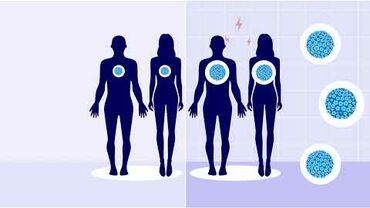Factsheet for the general public - Antimicrobial resistance
What are antibiotics?
Antibiotics, also known as antimicrobial drugs, are medicines that can kill or inhibit the growth of bacteria to cure infections in people, animals and sometimes plants. Antibiotics are medicines for bacterial infections (such as pneumococcal pneumonia or staphylococcal bloodstream infections); antimicrobial drugs that are effective against viruses are usually called antiviral drugs (such as those for influenza, HIV and herpes). Not all antibiotics are active against all bacteria. There are more than 15 different classes of antibiotics that differ in their chemical structure and their action against bacteria. An antibiotic may be effective against only one or multiple types of bacteria.
What is antibiotic resistance?
Bacteria have antibiotic resistance when specific antibiotics have lost their ability to kill or stop the growth of the bacteria. Some bacteria are naturally resistant to certain antibiotics (intrinsic or inherent resistance). A more worrying problem is when some bacteria, that are normally susceptible to antibiotics, become resistant as a result of genetic changes (acquired resistance). Resistant bacteria survive in the presence of the antibiotic and continue to multiply causing longer illness or even death. Infections caused by resistant bacteria may require more care as well as alternative and more expensive antibiotics, which may have more severe side effects.
Causes of antibiotic resistance
What is the most important cause of antibiotic resistance?
Antibiotic resistance is a natural occurrence caused by mutations in bacteria’s genes. However, excessive and inappropriate use of antibiotics accelerates the emergence and spread of antibiotic-resistant bacteria. When exposed to antibiotics, susceptible bacteria are killed and resistant bacteria can continue to grow and multiply. These resistant bacteria may spread and cause infections in other people who have not taken any antibiotics.
What is “inappropriate” use of antibiotics?
When you use antibiotics for the wrong reason: most colds and flu are caused by viruses against which antibiotics are NOT effective. In such cases, you won’t improve your condition by taking antibiotics: antibiotics don’t lower fever or symptoms like sneezing.
When you use antibiotics incorrectly: if you shorten the duration of treatment, lower the doses, don’t comply with the right frequency (taking the drug once a day instead of 2 or 3 times a day as directed), you won’t have enough drug in your body and the bacteria will survive and may become resistant.
Always follow your doctor’s advice on when and how to use antibiotics.
Which diseases are caused by resistant bacteria?
Multidrug-resistant bacteria can cause a wide range of infections: urinary tract infection, pneumonia, skin infection, diarrhoea, bloodstream infection. The location of the infection depends on the bacteria and the patient’s condition.
Patients in hospitals are at risk for infections unrelated to the reason for admission, including bloodstream and surgical site infections like MRSA (caused by Staphylococcus aureus resistant to methicillin, an antibiotic representative of those which are usually effective against Staphylococcus aureus), bloodstream infections caused by Enterobacteriaceae producing ESBL (extended-spectrum beta-lactamases, enzymes able to destroy some antibiotics), heartvalve infections caused by Enteroccocci resistant to vancomycin, and surgical site and wound infections caused by Acinetobacter baumannii resistant to carbapenems.
The problem of antibiotic resistance
Why is antibiotic resistance a problem?
Treating infections due to resistant bacteria is a challenge: antibiotics commonly used are no longer effective and doctors have to choose other antibiotics. This may delay getting the right treatment to patients and may result in complications, including death. Also, a patient may need more care as well as alternative and more expensive antibiotics, which may have more severe side effects.
How serious is the problem?
The situation is getting worse with the emergence of new bacterial strains resistant to several antibiotics at the same time (known as multidrug-resistant bacteria). Such bacteria may eventually become resistant to all existing antibiotics. Without antibiotics, we could return to the “pre-antibiotic era”, when organ transplants, cancer chemotherapy, intensive care and other medical procedures would no longer be possible. Bacterial diseases would spread and could no longer be treated, causing death.
Is the problem worse than in the past?
Before the discovery of antibiotics, thousands of people died from bacterial diseases, such as pneumonia or infection following surgery. Since antibiotics have been discovered and used, more and more bacteria, which were originally susceptible, have become resistant and developed numerous different means of fighting against antibiotics. Because resistance is increasing and few new antibiotics have been discovered and marketed in recent years, the problem of antibiotic resistance is now a major public health threat.
What can be done to solve the problem?
Keeping antibiotics effectives is everyone’s responsibility. Responsible use of antibiotics can help stop resistant bacteria from developing and help keep antibiotics effective for the use of future generations. On this basis, it is important to known when it is appropriate to take antibiotics and how to take antibiotics responsibly. Successful public awareness campaigns, which have already taken place in some countries, have resulted in a reduction of antibiotic consumption.
Everyone can play an important role in decreasing antibiotic resistance
Patients:
- Follow your doctor’s advice when taking antibiotics.
- When possible, prevent infection through appropriate vaccination.
- Wash your hands and your children’s hands regularly, for instance after sneezing or coughing before touching other things or people.
- Always use antibiotics under medical prescription, not using “leftovers” or antibiotics obtained without a prescription.
- Ask your pharmacist about how to dispose of the remaining medicines.
Doctors and other healthcare professionals, e.g. pharmacists and nurses:
- Prescribe antibiotics only when necessary, according to evidence-based guidelines. When possible, prescribe an antibiotic that is specific to the infection and not “broad spectrum”.
- Explain to patients how to relieve symptoms of colds and flu without antibiotics.
- Advise patients why it is important that they comply with the treatment when they are prescribed antibiotics by a doctor.
Antibiotic resistance in Europe
Is antibiotic resistance a problem in Europe?
Surveillance data show that antimicrobial resistance is a growing public health problem in European hospitals and communities. Escherichia coli resistance to major antibiotics is increasing in almost all countries in Europe. E. coli causes urinary tract and more serious infections and is one of the most common bacteria causing infections.
To address this public health concern, the Council of the European Union issued a recommendation in 2001 asking countries to put in place actions to ensure prudent use of antibiotics (Council recommendation of 15 November 2001 on the prudent use of antimicrobial agents in human medicine (2002/77/EC)). Some countries launched national programmes, including public awareness campaigns, several years ago and have observed a decrease in both consumption of antibiotics and in antibiotic resistance.
Why are some countries more affected than others?
There are many reasons for different rates of resistance that can include antibiotic use, underlying diseases, quality of hospital care, immunisation rates and social factors. It is not always possible to determine the proportion of resistant infections caused by a single factor. Data from the European Antimicrobial Resistance Surveillance Network (EARS-Net) show that there is a gradient North-South with low rates in Scandinavian countries and the Netherlands and high rates in Southern Europe. Countries with lower resistance rates have generally lower use of antibiotics, whereas countries with higher antibiotic resistance rates use more antibiotics.
What is the resistance situation in other regions in the world?
Inappropriate use of antibiotics is a problem worldwide. The World Health Organization (WHO) issued a global strategy and guidelines to help countries in setting up systems to monitor antibiotic resistance and to implement efficient actions (for instance, insuring that antibiotics can only be purchased with prescription). While people still die in developing countries because they lack the correct antibiotic treatment, antibiotic resistance resulting from inappropriate use is causing concern in every continent.
Antibiotic resistance and food-producing animals
Which antibiotics are used in food-producing animals? Are they related to antibiotics used in humans?
Antibiotics used to treat and prevent bacterial infections in animals belong to the same chemical groups as those used for humans: macrolides, tetracyclines, quinolones, beta-lactams, aminoglycosides. Therefore, animals may acquire bacteria that are resistant to antibiotics also used against human infections.
Does the use of antibiotics in food-producing animals contribute to the problem?
Certain resistant bacteria that are associated with food consumption, such as Campylobacter or Salmonella, may be transferred from animals to humans through food. People may also acquire resistant bacteria from direct contact with animals. However, the major cause of antibiotic resistance in humans remains the use of antibiotics in human medicine.
MRSA
What is MRSA?
Staphylococcus aureus is a common bacterium, present on skin and mucosa in 20% to 30% of healthy people. It may sometimes causes infections if it is introduced into the body. It typically causes skin and wound infections but can cause pulmonary, surgical site, bloodstream, heart, bone and other invasive infections. When it is resistant to methicillin (or to oxacillin, a type of penicillin), it is called MRSA or “Methicillin-Resistant Staphylococcus aureus”. Typically, MRSA that is found in hospitals is resistant to many other antibiotics.
What are the causes of MRSA?
MRSA is mainly acquired through direct contact from human to human or via equipment or medical devices. Antibiotic use is also associated with higher risk of acquiring MRSA.
What are the risks of MRSA in hospitals?
In hospitals, MRSA may be introduced in blood or other tissue in the body on several occasions during care, especially when performing invasive procedures such as surgery, injection, ventilation. It can then cause local skin infections or more life-threatening infections such as pneumonia, bloodstream infections and surgical site infections. To reduce this risk, hospitals put in place preventive actions: hand-washing or disinfection with alcohol-based solution, antisepsis before performing surgery, screening and isolation of patients at high risk of carrying resistant bacteria, and prudent use of antibiotics.
What are the risks of MRSA in the community?
In the community, MRSA infections may occur if MRSA is introduced into the body through broken skin. Community-associated MRSA (CA-MRSA) infections have been described in several countries, e.g. in athletic teams and prisons in North America, and transmission has been documented among family members. Common characteristic appears to be close person-to-person contact. CA-MRSA infections are mainly skin infections (boils), abscesses; sometimes more severe infections may occur (e.g. bloodstream infections), above all if CA-MRSA produces a toxin, such as Panton-Valentine Leukocidin (PLV).
How can I protect myself/my family from MRSA?
The most important thing to protect yourself and your family from MRSA is to comply with simple hygiene measures: clean and cover wounds, cuts and scrapes, keep your hands clean until they are healed, and avoid sharing personal items such as razors and towels. If you catch an infection due to MRSA, ask your doctor or nurse about which hygiene measures you and your family will have to comply with, in hospital and when you go back home.
Escherichia coli
What is Escherichia coli?
Escherichia coli or E. coli is one of the most common bacteria in the digestive tract (gut) of each of us. It belongs to a family of bacteria called Enterobacteriacae (that also include Klebsiella species and Enterobacter species). E. coli is generally harmless but may sometimes cause infections, mainly urinary tract infections. In recent years, an increase in infections due to E. coli resistant to many antibiotics at the same time, including fluoroquinolones and third-generation cephalosporins, has been reported.
What are the causes of resistant E. coli?
Previous antibiotic treatment, e.g. with fluoroquinolones, has been associated with higher risks of resistance in E. coli. Resistant E. coli may then spread between people.
What are the risks of resistant E. coli in hospitals?
The risk in hospitals is that E. coli from your own gut could be introduced in blood or other tissue when performing invasive procedures such as surgery or injection. It may also be transmitted from another person via direct contact (hands). It can then cause a wide range of infections, such as urinary tract infections, pneumonia, bloodstream infections and surgical site infections. To reduce this risk, hospitals put in place preventive actions: prudent use of antibiotics, antisepsis before performing surgery, aseptic procedures to prevent urinary tract infections, hand hygiene, and screening of patients at high risk of carrying resistant bacteria.
What are the risks of resistant E. coli in the community?
The main risk factors for resistant E. coli in the community are previous antibiotic treatment. Getting an effective treatment for urinary tract infection due to resistant E. coli may be delayed, possibly resulting in serious complications such as kidney or bloodstream infection.



